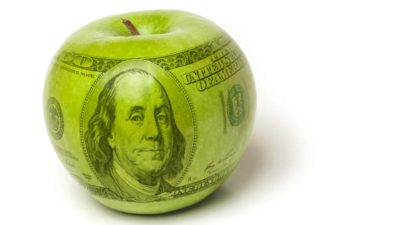This article was originally published on Fool.com. All figures quoted in US dollars unless otherwise stated.
Want to double your money? There's no shortage of suggestions for how to do that out there. Some will urge you to gamble, invest with borrowed money, chase high-flying stocks, try to time the market, or speculate in commodities and futures. Others will suggest the lottery or penny stocks or other ways that are so risky you'll likely lose money.
If you really want to double your money, though, and do it with your precious, hard-earned dollars, it's best to stick with unassailable methods.
The Rule of 72
It's hard to argue with math, and there's a simple mathematical trick that can help you figure out how long it will take to double your money -- the Rule of 72. Per the rule, if you divide 72 by an annual growth (or interest) rate, you'll get the number of years it will take to double your money.
If you expect a 10% annual return, for instance, divide 72 by 10 and you'll see that it'll take about 7.2 years to double your money. The rule works well, except when you're dealing with extreme numbers. An expected 72% growth rate might suggest doubling in a single year, but that would take a 100% growth rate. Check out the table below, to see the rule in action.
|
Growth Rate |
Years to Double |
|---|---|
|
2% |
36.0 |
|
3% |
24.0 |
|
5% |
14.4 |
|
7% |
10.3 |
|
10% |
7.2 |
|
12% |
6.0 |
|
15% |
4.8 |
|
20% |
3.6 |
|
25% |
2.9 |
Data source: Calculations by author.
Basically, though, doubling your money, or increasing it to any degree, depends on three simple factors:
- How much money you invest
- How long it has to grow
- How rapidly it will grow
By using any or all of those levers, you can influence how your money grows. Let's take a closer look at how you can adjust those levers:
No. 1: Save and invest more
It's obvious, but of course, in general, the more you invest, the more you can amass. The table below shows the different sums you might amass over various periods by investing $5,000, $10,000, or $15,000 annually:
|
Growing at 8% for |
$5,000 invested annually |
$10,000 invested annually |
$15,000 invested annually |
|---|---|---|---|
|
5 years |
$31,680 |
$63,359 |
$95,039 |
|
10 years |
$78,227 |
$156,455 |
$234,682 |
|
15 years |
$146,621 |
$293,243 |
$439,864 |
|
20 years |
$247,115 |
$494,229 |
$741,344 |
|
25 years |
$394,772 |
$789,544 |
$1,184,316 |
|
30 years |
$611,729 |
$1,223,459 |
$1,835,188 |
|
35 years |
$930,511 |
$1,861,021 |
$2,791,532 |
|
40 years |
$1,398,905 |
$2,797,810 |
$4,196,716 |
Data source: Calculations by author.
Many of us can't just sock away $15,000 or more each year, but you can still probably invest more than you're currently investing, and you can aim to increase your annual contributions to various savings accounts from year to year.
If you want to get aggressive about it, which is smart for many of us, especially those who have started late or who want to try to retire early, find lots of ways to spend less and consider picking up a side gig to earn a little more -- all to facilitate more investments.
No. 2: Invest for a longer period
The same table, above, shows the incredible power of time. Doubling the number of years in which your money can grow is likely to more than double how much you amass, thanks to the magic of compounding.
If you're not a spring chicken anymore, you may not have 25 or 35 years before retirement, but you can still amp up your savings by saving more each year -- and/or boosting your growth rate.
No. 3: Earn a greater rate of return
The growth rate is the last lever you can tweak. You can't simply produce a high growth rate, though. In general, risk and return are interrelated, with low-risk investments (savings accounts, government bonds) tending to offer low growth rates and high-risk propositions (junk bonds, lottery tickets) offering high (possible) rates.
Consider aiming for solid middle ground, by focusing much of your long-term money on stocks. Over long periods, stocks have handily outperformed bonds, and the stock market has averaged annual returns of close to 10% over long periods. You can hope to do better by carefully selecting a range of individual stocks, but that takes skill and knowledge and a rational temperament. For most of us, it's hard to beat a simple low-fee broad-market index fund or two, such as one that tracks the S&P 500.
The table below shows what a difference the growth rate makes, for annual investments of $10,000:
|
Growing for |
Growing at 6% |
Growing at 8% |
Growing at 10% |
|---|---|---|---|
|
10 years |
$139,716 |
$156,455 |
$175,312 |
|
15 years |
$246,725 |
$293,243 |
$349,497 |
|
20 years |
$389,927 |
$494,229 |
$630,025 |
|
25 years |
$581,564 |
$789,544 |
$1.1 million |
|
30 years |
$838,017 |
$1.2 million |
$1.8 million |
|
35 years |
$1.2 million |
$1.9 million |
$3.0 million |
|
40 years |
$1.6 million |
$2.8 million |
$4.9 million |
Data source: Calculations by author.
The tables above not only show how you can double your money, but given enough time and a solid rate of growth, how you might triple or quadruple it, as well!
This article was originally published on Fool.com. All figures quoted in US dollars unless otherwise stated.








